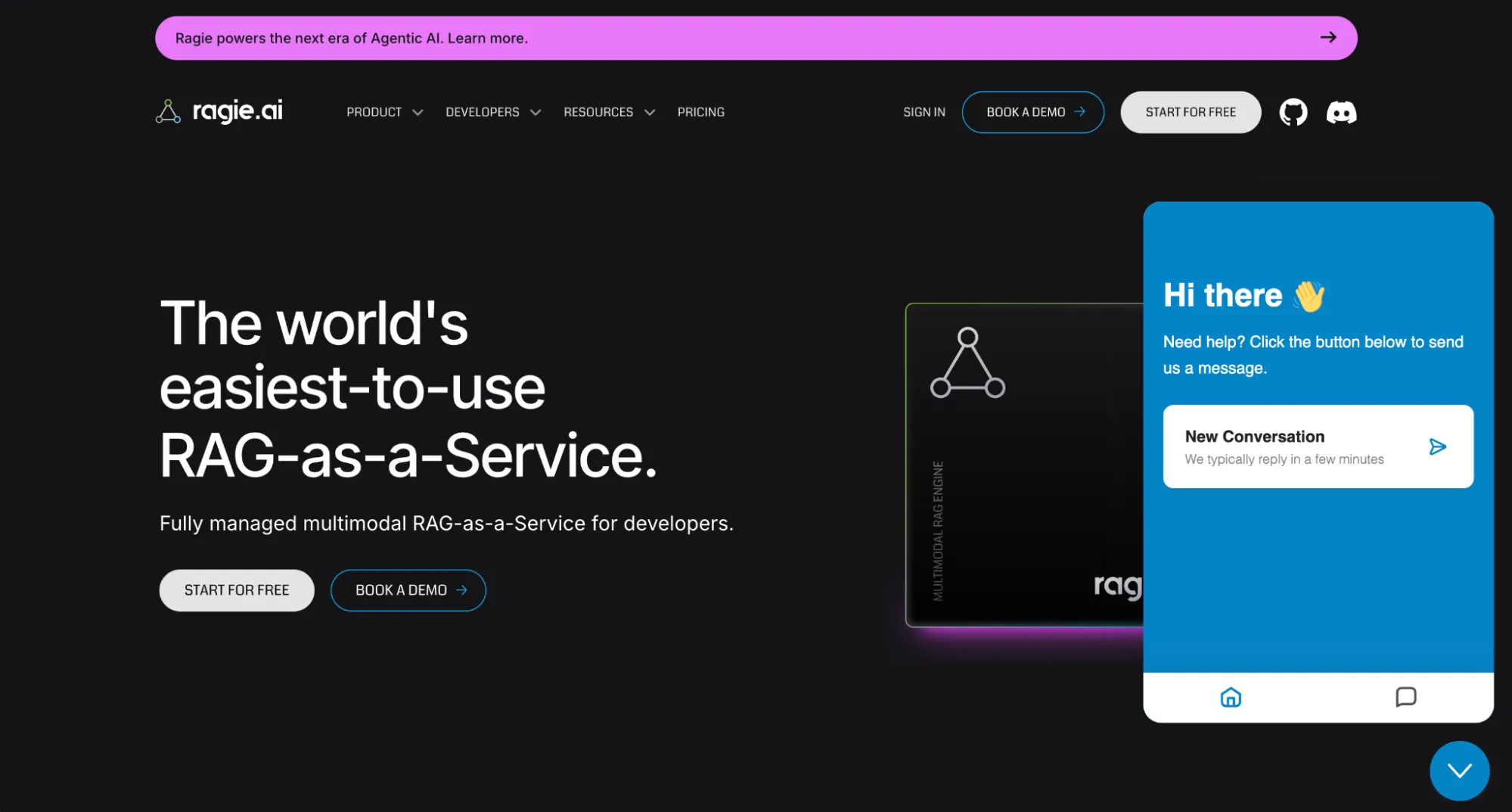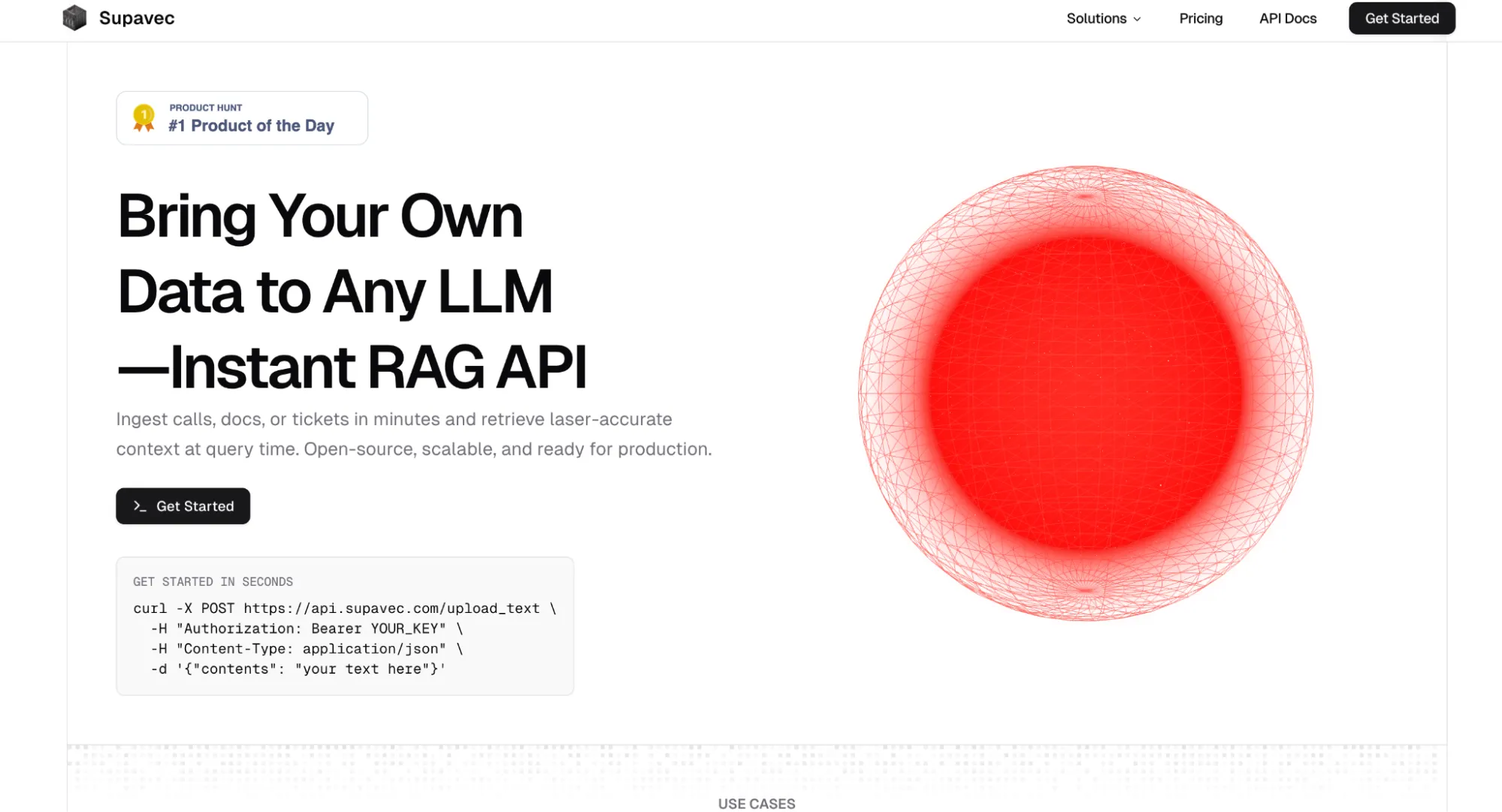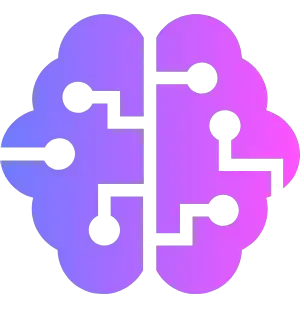Data Ingestion & Knowledge Sources
✅ Ready-Made Connectors – Google Drive, Gmail, Notion, Confluence auto-sync data automatically✅ Multi-Format Upload – PDF, DOCX, TXT, Markdown, URL/sitemap crawling supported✅ Automatic Retraining – Manual or automatic knowledge base updates keep RAG current✅ Real-Time Indexing – Launch RAG pipelines with immediate content updates and synchronization
REST API Upload – PDFs, Markdown, TXT via API endpoints or raw textNo Pre-Built Connectors – ⚠️ Script your own Google Drive/Notion fetchersOpen Source Extensibility – ✅ Build connectors to Postgres, MongoDB, S3Supabase Scalability – Handles millions of docs with horizontal scaling
1,400+ file formats – PDF, DOCX, Excel, PowerPoint, Markdown, HTML + auto-extraction from ZIP/RAR/7Z archivesWebsite crawling – Sitemap indexing with configurable depth for help docs, FAQs, and public contentMultimedia transcription – AI Vision, OCR, YouTube/Vimeo/podcast speech-to-text built-inCloud integrations – Google Drive, SharePoint, OneDrive, Dropbox, Notion with auto-syncKnowledge platforms – Zendesk, Freshdesk, HubSpot, Confluence, Shopify connectorsMassive scale – 60M words (Standard) / 300M words (Premium) per bot with no performance degradation
✅ Multi-Channel – Slack, Telegram, WhatsApp, Facebook Messenger, Microsoft Teams, chat widget✅ Webhooks & Zapier – External actions: tickets, CRM updates, workflow automation✅ Support Workflows – Real-time chat, easy escalation, customer-support focused design⚠️ No Native UI – RAG API platform requires custom chat interface development
Pure REST API – No built-in widget or messaging platform botsDIY Front-End – ⚠️ Code your own chat UI or Slack bridgeHTTP Compatibility – ✅ Any HTTP-capable app can integrateNo Zapier – ⚠️ Webhooks and automations are manual
Website embedding – Lightweight JS widget or iframe with customizable positioningCMS plugins – WordPress, WIX, Webflow, Framer, SquareSpace native support5,000+ app ecosystem – Zapier connects CRMs, marketing, e-commerce toolsMCP Server – Integrate with Claude Desktop, Cursor, ChatGPT, WindsurfOpenAI SDK compatible – Drop-in replacement for OpenAI API endpointsLiveChat + Slack – Native chat widgets with human handoff capabilities
✅ RAG Architecture – Context-aware answers from your data only, reduces hallucinations significantly✅ Multi-Turn Context – Full session history, 95+ languages out of box✅ Lead Capture – Automatic lead capture with human escalation on demand✅ Fallback Handling – Human handoff and messages when bot confidence low
Basic RAG – Retrieve chunks + LLM answer, stateless callsNo Chat History – ⚠️ No built-in conversation trackingNo Lead Capture – ⚠️ No human handoff or escalation featuresFast Retrieval – ✅ Pulls relevant text quickly for LLM response
✅ #1 accuracy – Median 5/5 in independent benchmarks, 10% lower hallucination than OpenAI✅ Source citations – Every response includes clickable links to original documents✅ 93% resolution rate – Handles queries autonomously, reducing human workload✅ 92 languages – Native multilingual support without per-language config✅ Lead capture – Built-in email collection, custom forms, real-time notifications✅ Human handoff – Escalation with full conversation context preserved
✅ Widget Customization – Logos, colors, welcome text, icons match brand perfectly✅ White-Label – Remove Ragie branding entirely for clean deployment✅ Domain Allowlisting – Lock bot to approved sites for security⚠️ Moderate Customization – Not as extensive as fully white-labeled custom solutions
No Pre-Made UI – Branding lives in your custom front-endWhite-Label by Default – ✅ API-only means no Supavec brandingFull Control – Add domain checks and auth in your code
Full white-labeling included – Colors, logos, CSS, custom domains at no extra cost2-minute setup – No-code wizard with drag-and-drop interfacePersona customization – Control AI personality, tone, response style via pre-promptsVisual theme editor – Real-time preview of branding changesDomain allowlisting – Restrict embedding to approved sites only
✅ OpenAI GPT-4o – Primary "accurate" mode for depth, advanced reasoning, quality✅ GPT-4o-mini – "Fast" mode balances quality with speed for volume✅ Claude 3.5 Sonnet – Confirmed support through RAG-as-a-Service architecture integration✅ Mode Toggle – Switch fast/accurate modes per chatbot without code changes⚠️ No Model Agnosticism – OpenAI/Claude only; no Llama, Mistral, custom deployment
Model-Agnostic – Defaults to GPT-3.5, switch to GPT-4 or self-hostedSimple Config – Change model via config or prompt pathNo Prompt Magic – ⚠️ Plain RAG without anti-hallucination layerQuality Dependency – ⚠️ Rests on your LLM choice and prompting
GPT-5.1 models – Latest thinking models (Optimal & Smart variants)GPT-4 series – GPT-4, GPT-4 Turbo, GPT-4o availableClaude 4.5 – Anthropic's Opus available for EnterpriseAuto model routing – Balances cost/performance automaticallyZero API key management – All models managed behind the scenes
Developer Experience ( A P I & S D Ks)
✅ REST API – Complete coverage: bot management, data ingestion, answers, clear docs✅ TypeScript/Python SDKs – Official SDKs for production-grade RAG development workflows✅ No-Code Builder – Drag-and-drop dashboard for non-devs, API for heavy lifting✅ SourceSync API – Headless RAG layer for fully customizable retrieval backends
Straightforward REST – File uploads, text uploads, search endpointsNo Official SDKs – ⚠️ Use fetch/axios or build wrapperConcise Docs – JS snippets with Postman collection includedOpen Source on GitHub – ✅ Community contributions welcome
REST API – Full-featured for agents, projects, data ingestion, chat queriesPython SDK – Open-source customgpt-client with full API coveragePostman collections – Pre-built requests for rapid prototypingWebhooks – Real-time event notifications for conversations and leadsOpenAI compatible – Use existing OpenAI SDK code with minimal changes
✅ Hybrid Search – Re-ranking, smart partitioning, semantic + keyword retrieval✅ Fast/Accurate Modes – Speed-optimized or depth-focused responses per configuration✅ Citation Support – Answers grounded in sources with traceable references✅ Entity Extraction – Structured data from unstructured documents for advanced querying
Standard GPT RAG – Accuracy equals GPT quality plus RAG liftFast Vector Search – Postgres pgvector keeps retrieval snappyNo Benchmarks – ⚠️ Expect typical GPT-3.5/4 RAG performanceManual Citations – ⚠️ Prompt-engineer your own validation
Sub-second responses – Optimized RAG with vector search and multi-layer cachingBenchmark-proven – 13% higher accuracy, 34% faster than OpenAI Assistants APIAnti-hallucination tech – Responses grounded only in your provided contentOpenGraph citations – Rich visual cards with titles, descriptions, images99.9% uptime – Auto-scaling infrastructure handles traffic spikes
Customization & Flexibility ( Behavior & Knowledge)
✅ KB Updates – Hit "retrain," recrawl, upload files anytime in dashboard✅ Personas & Prompts – Set tone, style, quick prompts for behavior✅ Multiple Bots – Spin up bots per team/domain under one account✅ Functions Feature – Perform actions (tickets, CRM) directly in chat
Instant Re-Embedding – ✅ Upload/overwrite docs with near-instant reindexPrompt-Based Behavior – ⚠️ No GUI for personas or rulesMulti-Lingual Support – Tell LLM in your prompt for languageMetadata & Chunking – Add custom metadata and build logic around it
Live content updates – Add/remove content with automatic re-indexingSystem prompts – Shape agent behavior and voice through instructionsMulti-agent support – Different bots for different teamsSmart defaults – No ML expertise required for custom behavior
✅ Growth Plan – ~$79/month for small teams, basic multi-channel support✅ Pro/Scale Plan – ~$259/month with expanded capacity, messages, bots, crawls✅ Enterprise Plan – Custom pricing for large deployments, dedicated support, SLAs✅ Smooth Scaling – Message credits scale costs with usage, no linear explosions✅ 7-Day Free Trial – Full feature access to test everything risk-free
MIT Open Source – ✅ Self-host free with your infrastructure costsHosted Plans – Free (100 calls/mo), $190/yr (750 calls), $1,490/yr (5K calls)No Storage Metering – Only query volume counts toward limitsNegotiate or Self-Host – Scale beyond caps with custom limits
Standard: $99/mo – 60M words, 10 botsPremium: $449/mo – 300M words, 100 botsAuto-scaling – Managed cloud scales with demandFlat rates – No per-query charges
✅ HTTPS/TLS & Encryption – Industry standard in-transit, data-at-rest encryption protection✅ Workspace Isolation – Customer data stays isolated, no cross-tenant leakage✅ SOC 2/GDPR/HIPAA – Type II certified, GDPR/HIPAA/CASA/CCPA compliant infrastructure✅ Access Controls – Dashboard permissions, API key management, audit logging⚠️ Cloud-Only SaaS – No on-premise/air-gapped deployment options for regulated industries
Self-Hosting Privacy – ✅ Everything on your servers for complianceSupabase RLS – Row-level security fences team data when hostedNo Model Training – ✅ Your docs never used for LLM trainingGDPR/HIPAA Ready – Self-host for compliance on your infrastructure
SOC 2 Type II + GDPR – Third-party audited complianceEncryption – 256-bit AES at rest, SSL/TLS in transitAccess controls – RBAC, 2FA, SSO, domain allowlistingData isolation – Never trains on your data
Observability & Monitoring
✅ Dashboard Metrics – Chat histories, sentiment, key performance indicators displayed✅ Daily Digests – Email summaries keep team informed without logins⚠️ Basic Analytics – Not as comprehensive as dedicated conversation analytics platforms
No Built-In Dashboard – ⚠️ Log requests yourself or use Supabase metricsBasic Call Counts – Hosted plan shows simple usage statsExternal Logging – Wire up your own monitoring tools
Real-time dashboard – Query volumes, token usage, response timesCustomer Intelligence – User behavior patterns, popular queries, knowledge gapsConversation analytics – Full transcripts, resolution rates, common questionsExport capabilities – API export to BI tools and data warehouses
✅ Email Support – 24-48hr response; faster for Enterprise customers✅ Submit Request Form – Feature requests, integration suggestions, custom needs✅ Partner Program – Agency partnerships for consultants, resellers, ecosystem growth✅ Live Demo – Interactive environment for evaluating platform before trial⚠️ No Phone Support – Email-based on standard plans; phone likely Enterprise-only
Community Help – GitHub/Discord for free tier and self-hostedEmail Support – Paid plans get email support with priority levelsLean Docs – ⚠️ Endpoint references, not extensive tutorialsOpen-Source PRs – ✅ Forks and contributions welcome
Comprehensive docs – Tutorials, cookbooks, API referencesEmail + in-app support – Under 24hr response timePremium support – Dedicated account managers for Premium/EnterpriseOpen-source SDK – Python SDK, Postman, GitHub examples5,000+ Zapier apps – CRMs, e-commerce, marketing integrations
✅ Agentic Retrieval – Multi-step engine: decomposes queries, self-checks, compiles cited answers✅ MCP Server – Context-Aware descriptions enable accurate agent tool routing decisions✅ Multi-Step Reasoning – Sequential retrieval operations with self-validation for complex queries✅ Summary Index – Avoid document affinity problems through intelligent summarization⚠️ No Built-In UI – API platform requires custom chat interfaces, not turnkey
Stateless RAG – Pure retrieval + generation without conversation statePostgres Vector Search – ✅ Fast pgvector with cosine similarityMetadata Filtering – Custom tagging for organized knowledgeSupabase Integration – Built on PostgreSQL with RLS securityNo Chat UI – ⚠️ API-only, build your own interfaceNo Advanced RAG – ⚠️ Missing hybrid search, knowledge graphs, reranking
Custom AI Agents – Autonomous GPT-4/Claude agents for business tasksMulti-Agent Systems – Specialized agents for support, sales, knowledgeMemory & Context – Persistent conversation history across sessionsTool Integration – Webhooks + 5,000 Zapier apps for automationContinuous Learning – Auto re-indexing without manual retraining
Additional Considerations
✅ Functions Feature – Bot performs real actions (tickets, CRM) in chat✅ Headless API – SourceSync gives devs fully customizable retrieval layer✅ Free Developer Tier – Test production-grade RAG infrastructure without commitment⚠️ Functions Complexity – Advanced workflows require technical setup, not fully no-code
N/A
Time-to-value – 2-minute deployment vs weeks with DIYAlways current – Auto-updates to latest GPT modelsProven scale – 6,000+ organizations, millions of queriesMulti-LLM – OpenAI + Claude reduces vendor lock-in
No- Code Interface & Usability
✅ Guided Dashboard – Paste URL or upload files, up running fast✅ Pre-Built Templates – Live demo, simple embed snippet for painless deployment✅ In-Platform Guidance – Visual walkthrough of configuration, deployment for no-code users✅ Knowledge Base – Self-service docs covering setup, integrations, troubleshooting guides
N/A
2-minute deployment – Fastest time-to-value in the industryWizard interface – Step-by-step with visual previewsDrag-and-drop – Upload files, paste URLs, connect cloud storageIn-browser testing – Test before deploying to productionZero learning curve – Productive on day one
✅ Market Position – Developer-friendly RAG balancing no-code dashboard with API flexibility✅ Target Customers – SMBs needing quick chatbot, multi-channel teams, devs wanting flexibility✅ Key Competitors – Chatbase.co, Botsonic, SiteGPT, CustomGPT, SMB no-code chatbot platforms✅ Competitive Advantages – Hybrid search, SourceSync API, Functions, 95+ languages, ready connectors✅ Pricing Advantage – Mid-range $79-$259/month, straightforward tiers, smooth scaling, best value✅ Use Case Fit – Multi-channel support, simple REST API, webhook/Zapier CRM/ticket integration
Market Position – MIT open-source RAG API on SupabaseTarget Customers – Developers building custom RAG, budget-conscious startupsKey Competitors – Carbon.ai, LangChain, SimplyRetrieve, hosted RAG APIsAdvantages – ✅ MIT license, Supabase foundation, model-agnostic, privacy-focusedBest For – Lightweight RAG backend, self-hosting, avoiding platform costs
Market position – Leading RAG platform balancing enterprise accuracy with no-code usability. Trusted by 6,000+ orgs including Adobe, MIT, Dropbox.Key differentiators – #1 benchmarked accuracy • 1,400+ formats • Full white-labeling included • Flat-rate pricingvs OpenAI – 10% lower hallucination, 13% higher accuracy, 34% fastervs Botsonic/Chatbase – More file formats, source citations, no hidden costsvs LangChain – Production-ready in 2 min vs weeks of development
✅ OpenAI GPT-4o – "Accurate" mode for depth, comprehensive analysis, highest quality✅ GPT-4o-mini – "Fast" mode balances quality with rapid response times✅ Claude 3.5 Sonnet – Anthropic integration enables Claude model deployment in production✅ 2024 Models – Updated for latest including gpt-4o-mini long-context improvements⚠️ Limited Selection – Only GPT-4o/mini toggle; no multi-model routing by complexity
GPT-3.5 Default – Cost-effective with GPT-4/4-turbo supportSelf-Hosted Models – ✅ Llama, Mistral via API endpointsNo Model Lock-In – ✅ Switch by changing configDirect API Keys – ✅ Connect your own OpenAI without markup
OpenAI – GPT-5.1 (Optimal/Smart), GPT-4 seriesAnthropic – Claude 4.5 Opus/Sonnet (Enterprise)Auto-routing – Intelligent model selection for cost/performanceManaged – No API keys or fine-tuning required
✅ Hybrid Search – Semantic vector + keyword retrieval for comprehensive document matching✅ Re-Ranking Engine – Surfaces most relevant content from retrieved docs✅ Smart Partitioning – Intelligent chunking for optimized retrieval across large KBs✅ Citation Support – Answers grounded in sources with traceable transparency✅ 95+ Languages – Multilingual RAG without separate configurations for global bases⚠️ Retraining Workflow – Manual retraining unless automatic mode enabled, not real-time
Standard RAG – Document chunking with Postgres pgvector searchOpenAI Embeddings – Automatic embedding generation on uploadFast Re-Indexing – ✅ Almost instant document updatesNo Advanced Features – ⚠️ No hybrid search, reranking, or multi-queryNo Hallucination Detection – ⚠️ Implement citations manually
GPT-4 + RAG – Outperforms OpenAI in independent benchmarksAnti-hallucination – Responses grounded in your content onlyAutomatic citations – Clickable source links in every responseSub-second latency – Optimized vector search and cachingScale to 300M words – No performance degradation at scale
✅ Customer Support – Self-service bots from help articles, reduce tickets up to 70%✅ Internal Assistants – Employee-facing AI with Google Drive, Notion, Confluence knowledge✅ Multi-Channel Support – Unified deployment: Slack, Telegram, WhatsApp, Messenger, Teams✅ Website Widgets – Real-time engagement, lead capture, instant question answering✅ CRM Integration – Functions create tickets, update CRM, trigger workflows from chat
Custom Chatbot Backends – Developers building own chat interfacesSelf-Hosted Retrieval – ✅ Data sovereignty with Supabase infrastructureBudget RAG Apps – Startups minimizing costs with MIT licenseSupabase Projects – Teams already using Supabase stackNot Ideal For – ⚠️ Non-technical teams or advanced RAG needs
Customer support – 24/7 AI handling common queries with citationsInternal knowledge – HR policies, onboarding, technical docsSales enablement – Product info, lead qualification, educationDocumentation – Help centers, FAQs with auto-crawlingE-commerce – Product recommendations, order assistance
✅ AES-256 & TLS – Encryption at rest and in transit, zero training use✅ SOC 2 Type II – Certified for GDPR, HIPAA, CASA, CCPA compliance✅ Domain Allowlisting – Lock chatbots to approved domains for security✅ Audit Logging – Activity tracking for compliance monitoring, incident investigation⚠️ Cloud-Only – No on-premise for air-gapped/highly regulated requirements
Self-Hosting Advantage – ✅ Complete data sovereignty on your serversSupabase RLS – Row-level security for multi-tenant isolationGDPR/HIPAA Ready – Self-host for compliance requirementsNo SOC 2 – ⚠️ Open-source lacks formal certificationsDIY Access Controls – ⚠️ Implement auth and RBAC yourself
SOC 2 Type II + GDPR – Regular third-party audits, full EU compliance256-bit AES encryption – Data at rest; SSL/TLS in transitSSO + 2FA + RBAC – Enterprise access controls with role-based permissionsData isolation – Never trains on customer dataDomain allowlisting – Restrict chatbot to approved domains
✅ Free Trial – 7 days full access, test everything risk-free✅ Growth – ~$79/month for small teams starting chatbot deployment✅ Pro/Scale – ~$259/month expanded capacity: messages, bots, crawls, uploads✅ Enterprise – Custom pricing for large deployments, dedicated support, SLAs✅ Transparent Pricing – Straightforward tiers without hidden fees or confusing per-feature charges
Free Self-Hosting – ✅ MIT license with only infrastructure costsHosted Free – 100 API calls/month for testingBasic $190/year – 750 calls/mo with email supportEnterprise $1,490/year – 5K calls/mo with priority support40-90% Cheaper – ✅ vs commercial RAG platforms
Standard: $99/mo – 10 chatbots, 60M words, 5K items/botPremium: $449/mo – 100 chatbots, 300M words, 20K items/botEnterprise: Custom – SSO, dedicated support, custom SLAs7-day free trial – Full Standard access, no chargesFlat-rate pricing – No per-query charges, no hidden costs
✅ Email Support – 24-48hr standard response; faster for Enterprise tier✅ REST API Docs – Clear documentation with live examples covering all endpoints✅ Daily Digests – Automated performance summaries, conversation metrics without logins✅ Partner Program – Agency partnerships for consultants, implementers, resellers ecosystem⚠️ No Phone Support – Email-based only on standard plans; phone Enterprise-reserved
Lean API Docs – ⚠️ Technical reference, not tutorial-heavyCommunity Support – GitHub Discussions and DiscordEmail for Paid – Basic/Enterprise get email supportPostman Collection – ✅ Quick testing and integration
Documentation hub – Docs, tutorials, API referencesSupport channels – Email, in-app chat, dedicated managers (Premium+)Open-source – Python SDK, Postman, GitHub examplesCommunity – User community + 5,000 Zapier integrations
R A G-as-a- Service Assessment
✅ Platform Type – TRUE RAG-AS-A-SERVICE API platform, August 2024, $5.5M seed✅ Core Mission – Developers build AI apps connected to data, outstanding RAG results✅ API-First Architecture – TypeScript/Python SDKs, reliable ingest, latest RAG techniques chunking/re-ranking✅ RAG Leadership – Summary Index, Entity Extraction, Agentic Retrieval, MCP Server✅ Managed Service – Free dev tier, pro for production, enterprise scale, no infrastructure⚠️ vs No-Code – No native widgets/Slack/WhatsApp/builders/analytics/lead capture, requires custom UI
TRUE RAG-AS-A-SERVICE API – Lightweight MIT open-source backendCarbon.ai Alternative – Created as transparent open-source responseTarget Market – Developers on budget, self-hosting for data sovereigntyStandard RAG – Document chunking, embeddings, pgvector searchAPI-First Design – ✅ Pure REST without GUI or widgetsAffordable Pricing – ✅ 40-90% cheaper than commercial platformsDeveloper Platform – ⚠️ Not for non-technical teams
Platform type – TRUE RAG-AS-A-SERVICE with managed infrastructureAPI-first – REST API, Python SDK, OpenAI compatibility, MCP ServerNo-code option – 2-minute wizard deployment for non-developersHybrid positioning – Serves both dev teams (APIs) and business users (no-code)Enterprise ready – SOC 2 Type II, GDPR, WCAG 2.0, flat-rate pricing
Limitations & Considerations
⚠️ OpenAI/Claude Only – Cannot deploy Llama, Mistral, custom open-source models⚠️ Cloud-Only – No self-hosting, on-premise, air-gapped for regulated industries⚠️ Message Credit Caps – High-volume requires plan upgrades or Enterprise pricing⚠️ Crawler Limits – URL/sitemap scope limited by plan tier, large sites need higher⚠️ Emerging Platform – Newer vs established competitors, smaller integration ecosystem
No GUI/Dashboard – ⚠️ Everything via API, no business-user interfaceDeveloper-Only – ⚠️ Requires coding for setup and integrationBasic RAG Only – ⚠️ No hybrid search, reranking, or query expansionNo Observability – ⚠️ Must build your own logging layerManual Connectors – ⚠️ Script your own Google Drive/Notion fetchesStateless API – ⚠️ No chat history or session management
Managed service – Less control over RAG pipeline vs build-your-ownModel selection – OpenAI + Anthropic only; no Cohere, AI21, open-sourceReal-time data – Requires re-indexing; not ideal for live inventory/pricesEnterprise features – Custom SSO only on Enterprise plan











Join the Discussion
Loading comments...